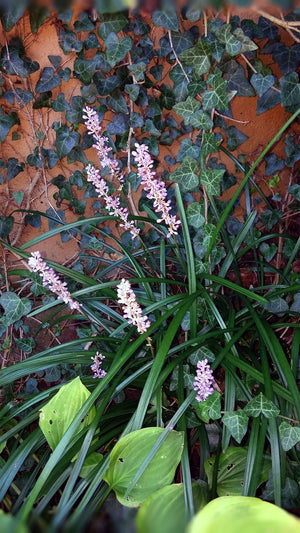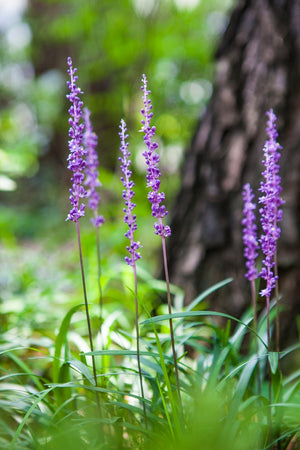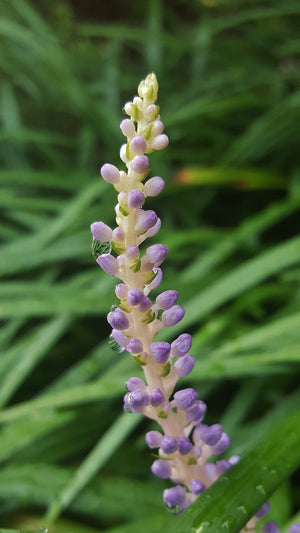The Liriope Guide
Liriope, often called lilyturf, is a dependable, grass-like perennial valued for its resilience, neat habit, and seasonal flower spikes. Whether used as a groundcover, edging plant, or erosion-control solution, liriope brings year-round structure and texture to the garden. Its ability to thrive in sun or shade and adapt to a variety of soils makes it one of the most versatile landscaping plants.

About
Liriope is native to East and Southeast Asia and belongs to the Asparagaceae family. It is often mistaken for ornamental grass, though it's more closely related to hostas and agapanthus. There are two primary species used in landscaping:
- Liriope muscari: Clumping habit with showy purple or white flower spikes and upright foliage. Popular cultivars include 'Big Blue', 'Royal Purple', 'Purple Explosion', and the pale 'Monroe's White'.
- Liriope spicata: A spreading form ideal for groundcover and erosion control. It grows more aggressively than L. muscari, and cultivars like 'Silver Dragon' add variegated interest.
Variegated types such as Liriope muscari 'Variegata' provide color contrast with creamy-yellow striped leaves, while 'Pee Dee Ingot' brings golden foliage to shady spots. Plants produce spiked blooms from late summer to fall, followed by small black berries in winter.

PLANTING
Liriope is low-maintenance and easy to establish, making it ideal for large plantings or tidy edges:
- USDA Hardiness Zones: Hardy in Zones 5–10.
- Soil: Well-draining soil is best, but liriope tolerates clay and poor soils once established.
- Sunlight: Thrives in full sun to part shade. Deep shade may reduce flower production but does not harm foliage.
- Spacing: For borders, space plants 12–18 inches apart. For mass plantings or erosion control, closer spacing (8–12 inches) promotes faster coverage.
- Planting Time: Best planted in spring or early fall when temperatures are moderate.
To plant as a border, dig a trench along the desired edge, amend the soil if necessary, and set liriope plants evenly spaced in a single line or staggered double row for a thicker edge.

CARE
Liriope requires little maintenance, yet a few seasonal tasks help keep it looking its best:
- Watering: Water regularly during establishment. Mature plants are drought-tolerant but benefit from occasional watering during prolonged dry spells.
- Fertilizing: Apply a slow-release fertilizer in early spring to promote lush foliage and abundant flowering.
- Pruning: Cut back foliage to a few inches in late winter or early spring before new growth emerges. This rejuvenates the plant and keeps it tidy.
- Dividing: Divide clumps every 3–5 years to maintain vigor and control spread. Replant immediately in prepared soil.
- Pests & Diseases: Generally pest-free, though crown rot can occur in wet or poorly drained soil.
Liriope's toughness and tolerance to urban conditions make it ideal for high-traffic landscapes, municipal plantings, and curbside borders.

HOW TO USE
Liriope’s structured form and grassy texture lend themselves well to formal and informal garden designs:
- Edging Paths and Beds: Use 'Big Blue', 'Emerald Goddess', or 'Variegata' along walkways or flower bed borders.
- Groundcover: Liriope spicata works well in shaded or sloped areas where it can spread and suppress weeds.
- Mass Plantings: Create a uniform look with large sweeps of 'Royal Purple' or 'Purple Explosion'.
- Understory Planting: Combine with ferns, hostas, hellebores, and carex for a layered shade garden.
- Containers: Variegated forms bring contrast and texture to mixed patio pots.
Liriope's foliage persists through winter in many regions, offering year-round interest even after flower spikes fade.

COMMON QUESTIONS
- How to plant liriope as a border? Dig a trench along your border, space plants 12–18 inches apart, and plant in a straight or staggered line for a clean, structured edge.
- When to cut back liriope? Trim back foliage in late winter or early spring before new growth appears.
- Is liriope deer resistant? Yes, liriope is generally deer resistant due to its tough, fibrous leaves.
- Is liriope toxic to dogs? Liriope is not considered toxic to dogs, but ingestion may cause mild gastrointestinal upset.
- Is liriope toxic to cats? Liriope is not toxic to cats, though eating large amounts of foliage could irritate digestion.
- What to plant with liriope? Pair with hostas, hellebores, astilbe, ferns, or ornamental grasses in shade-to-sun gardens.
- Do rabbits eat liriope? Liriope is usually avoided by rabbits due to its tough, fibrous leaves.
Conclusion
Liriope is a landscape staple that combines good looks with unbeatable adaptability. Whether edging a walkway or carpeting a slope, its evergreen foliage, late-summer blooms, and tolerance for sun, shade, drought, and deer make it a smart, low-maintenance choice. With thoughtful planting and occasional trimming, liriope delivers reliable structure and subtle color to the garden year after year.
